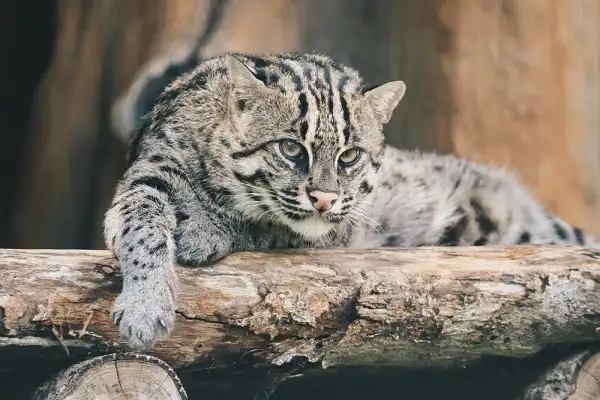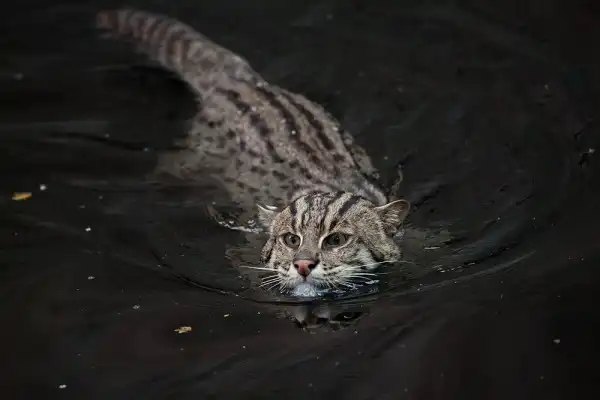Have you ever heard of a Fishing Cat creature? These mysterious cats inhabit some areas of Asia, though not many people know about them or where to locate them. With incredible swimming abilities and an impressive lifestyle, the fishing cat is truly an intriguing animal to behold. If you’ve ever been curious about this species, let’s dive right in! We’ll cover all aspects of these creatures – from their anatomy and behaviors on land and in water to the threats they face today – so that you can understand why these animals deserve our admiration and protection. Read on to learn more!

Fishing Cat Description
The Fishing Cat (Prionailurus viverrinus) is a species of small wildcat native to parts of South and Southeast Asia, primarily inhabiting wetlands and water-adjacent areas. This unique species is adapted to a semi-aquatic lifestyle and is the only wildcat species that regularly swim in pursuit of prey. Physically, it looks like a typical small cat with a rather stout body, short legs, and a short tail. Its fur is typically grayish-brown on its upper body with darker spots on its back and sides, while the underside is mostly white.
Its eyes are very notable due to their large size and yellowish-green irises. This creature has several features which make it well-adapted for swimming. It has webbed paws to aid in moving through the water, as well as long whiskers which provide sensory information about nearby objects in murky water conditions. Additionally, they have double layers of fur for insulation against cold waters which helps them stay warm while hunting for their prey beneath the surface.
Fishing Cat Habitat
The Fishing Cat is found across a wide range of habitats in South and Southeast Asia, mostly near wetlands. They often inhabit areas with shallow bodies of water such as rivers, streams, swamps, marshes, mangroves, and estuaries. Additionally, they can be found in areas with dense vegetation for cover on land and while hunting their prey. This species is quite adaptable when it comes to its habitat preferences, though it does prefer shallow waters where it can easily capture fish due to its strong swimming abilities.
It is also important for them to have dense vegetation nearby as cover on land so that they can remain hidden from potential predators. In some cases, they may even build dens by digging out burrows near water sources or by utilizing cavities found in trees. At the same time, these cats provide essential ecosystem services such as maintaining healthy wetlands by ensuring adequate water levels for aquatic vegetation growth and increasing oxygen levels through their breath bubbles which rise from the surface while swimming around looking for food below.
Fishing Cat Diet
The Fishing Cat diet consists primarily of fish and crustaceans such as crabs, prawns, and other small aquatic animals. Although they are adapted to living in water, these cats will also hunt on land for animals like rodents, birds, and frogs. While hunting in water they employ stalking tactics like sitting patiently on the bank before striking with lightning speed. Fishing cats have incredible swimming abilities which makes them well equipped for catching prey beneath the surface. Their webbed paws help them propel through the water while their long whiskers provide sensory information about nearby objects in murky conditions.
These cats usually hunt at night or during twilight hours when their prey is most active, though they may also feed during the day if the opportunity presents itself. Fishing cats are opportunistic hunters who thrive in a variety of environments and can take advantage of whatever resources are available to them – whether it be fish from a river or small rodents from a field. Although Fishing Cats mainly consume fish and other aquatic creatures, they do sometimes feed on plant material such as fruits and grasses when available. This provides additional nutrients that help maintain their health as well as supplement their diet when prey items are scarce due to changes in weather or seasonality.

Fishing Cat Size
Fishing cats are medium-sized cats, measuring between 16 to 27 inches in length from their head to the base of their tail. They typically weigh between 8 and 16 lbs, with males being slightly larger than females. Their fur is usually grayish brown in color and they have a white throat and chest. The fishing cat’s hind legs are longer than their front, giving them an elongated look that helps them move quickly and efficiently through the water. Additionally, they have webbed paws which help them swim even faster as well as extra long whiskers which provide sensory information about nearby objects in murky waters.
Fishing Cat Lifespan
The Fishing Cat has a lifespan of up to 12 years in the wild, though those in captivity can live longer with proper care. These cats reach sexual maturity at around 2 years old and usually spend their first year of life with their mother in order to learn essential hunting and survival skills. Female cats are able to breed every year apart from the time when they are caring for their young, while male cats often remain solitary unless they come across a female during mating season. Fishing Cats can survive in a variety of climates and environments, however, they need access to plentiful food sources which typically consist of fish, crustaceans, rodents, birds, frogs, and other small aquatic animals.
They require large amounts of clean fresh water as well as dense vegetation near bodies of water for cover on land when hunting or escaping predators. The Fishing Cat is considered an Endangered species due to habitat loss and degradation caused by human activity such as agricultural expansion or urban development. Other threats come from illegal hunting for the fur trade or sport as well as being caught inadvertently in fishing nets set by local fishermen.
Fishing Cat Behavior
Fishing cats are primarily solitary animals, with males and females coming together only during mating season. Females often have a range of several miles within which they hunt for food, while males typically roam larger territories. These cats are mostly nocturnal or crepuscular hunters, meaning that they hunt at night or just before dawn when their prey is most active. They use a variety of tactics such as stalking, ambushing, or diving beneath the surface to capture unsuspecting fish or other aquatic creatures. Fishing cats have powerful swimming abilities which make them well-equipped for catching prey beneath the surface of the water, using their webbed paws to propel their bodies through it quickly and efficiently.

Fishing Cat Speed
Fishing cats are relatively fast swimmers, able to reach speeds of around 6 miles per hour (9.6 kilometers per hour) in the water. They use their webbed feet and long body shape to propel themselves through the waters with great agility and speed. On land however, they are much less agile and only manage around a quarter of the speed they can swim at, making them vulnerable when confronted by larger predators such as tigers or leopards. In addition to their ability to swim quickly, fishing cats also have impressive reflexes which allow them to catch fish or other prey beneath the surface of the water with surprising accuracy.
This advantage is further enhanced by their long whiskers which provide sensory information about nearby objects and enable them to locate food even in murky waters. Furthermore, their sharp front claws also help them grab hold of slippery prey when needed. Fishing cats may usually be seen only within a few feet of the surface when hunting for food or trying to evade predators on land. When swimming underwater however, these felines can dive up to depths of up to 20 feet (six meters), enabling them to search for food in deeper waters where other species may not be able to reach easily due to lack of oxygen or darkness.
Fishing Cat Reproduction
Fishing cats reach sexual maturity at around two years old and usually breed every year apart from when they are caring for their young. Female Fishing Cats give birth to 2-4 kittens after a gestation period of 65-70 days in early spring or summer. The mother will instinctively move her kittens to different densities in order to keep them safe, as well as teach them important survival skills such as hunting and defending themselves against predators. The juveniles are born blind but open their eyes within 10 days of birth. As they grow, their coats gradually transition from an orange-brown color when they are born to a sandy gray color by the time they are fully mature adults. They begin hunting on their own at around 3 months old and become independent hunters by 6 months of age.
Fishing Cat Hunting
Fishing cats are masterful predators and are well-suited to their aquatic lifestyle. They have highly developed senses which aid in their ability to hunt beneath the surface of the water, including excellent eyesight and hearing, as well as strong olfactory senses for detecting prey nearby. Fishing cats also employ a variety of strategies when hunting, such as stalking, ambushing, or diving beneath the surface to capture unsuspecting prey. When searching for food near bodies of water or wetlands, fishing cats will usually remain close to the surface until they spot potential prey and then quickly dive underwater in pursuit.
They use their powerful webbed paws to propel themselves through the water with great speed and agility while searching for fish or other aquatic creatures. Additionally, they rely on their long whiskers to gain sensory information about nearby objects and help them locate food even in murky waters. Fishing cats typically hunt alone during times when prey items may be scarce due to seasonal fluctuations in weather patterns; however, if spotted by larger predators like tigers or leopards while hunting on land or underwater they can provide an essential source of food for them too.

Conclusion
Fishing cats are strong swimmers and skilled hunters. They also play an important role in regulating populations of small animals like fish, crustaceans, rodents, birds, frogs, and other aquatic creatures due to their role as predators. Additionally, they help maintain healthy water levels and increase oxygen levels due to their breath bubbles rising from the surface when swimming around in search of food. As such it is important that conservation efforts be undertaken both locally and nationally in order to protect these cats so that future generations can continue to enjoy them.
Frequently Asked Question

